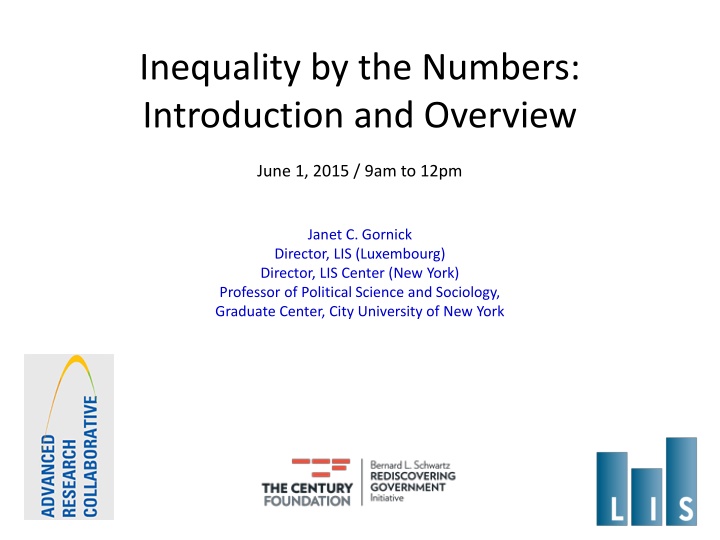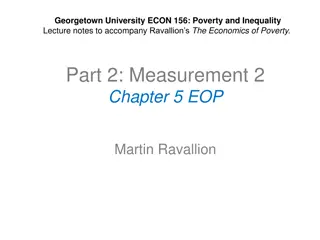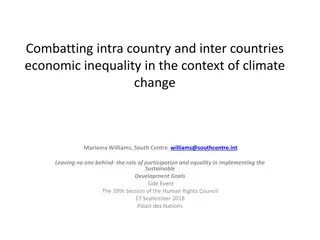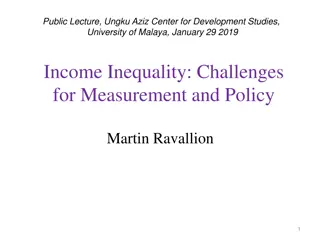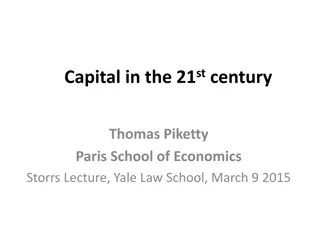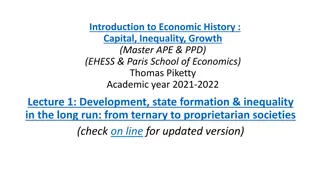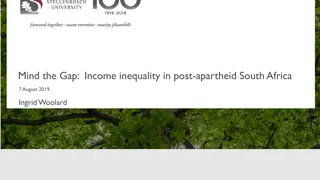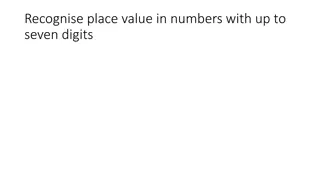Inequality by the Numbers: Introduction and Overview
Director Janet C. Gornick leads an exploration of income inequality, its causes, consequences, and the initiatives of LIS Center in Luxembourg. Learn about cross-national research and data archives that inform global socio-economic policy.
Download Presentation

Please find below an Image/Link to download the presentation.
The content on the website is provided AS IS for your information and personal use only. It may not be sold, licensed, or shared on other websites without obtaining consent from the author.If you encounter any issues during the download, it is possible that the publisher has removed the file from their server.
You are allowed to download the files provided on this website for personal or commercial use, subject to the condition that they are used lawfully. All files are the property of their respective owners.
The content on the website is provided AS IS for your information and personal use only. It may not be sold, licensed, or shared on other websites without obtaining consent from the author.
E N D
Presentation Transcript
Inequality by the Numbers: Introduction and Overview June 1, 2015 / 9am to 12pm Janet C. Gornick Director, LIS (Luxembourg) Director, LIS Center (New York) Professor of Political Science and Sociology, Graduate Center, City University of New York
9:00am to 10:15 Introduction: Inequality Workshop 2015 - sponsors, hosts, and senior colleagues - context / Graduate Center inequality initiatives - workshop participants - workshop instructors / scope - logistics for the week LIS: Cross National Data Center in Luxembourg LIS Center at Graduate Center, CUNY Q&A 10:15 to 10:45Coffee break 10:45 to 12:00pm Overview: Income inequality High and Rising Inequality: Causes and Consequences Q&A
9:00 to 10:15am Introduction: Inequality Workshop 2015 LIS: Cross National Data Center in Luxembourg LIS Center and Graduate Center, CUNY Q&A
Introduction: Inequality Workshop 2015 sponsors, hosts, and senior colleagues context / Graduate Center inequality initiatives workshop participants workshop instructors / scope logistics for the week
LIS in Luxembourg is a cross-national data archive and research center enables, facilitates, promotes, and conducts cross-national comparative research on socio-economic outcomes and on the institutional factors that shape those outcomes; acquires and harmonizes datasets and makes them available to scholars and analysts around the world; houses datasets from nearly 50 countries; about half include repeated cross-sections going back 2-3 decades; allows analysts to work with harmonized micro-data. http://www.lisdatacenter.org
LIS Center at Graduate Center, CUNY The Luxembourg Income Study Center, also known as the LIS Center, brings the resources of LIS to the Graduate Center. Senior scholars Janet Gornick, Professor and LIS Director [here] Branko Milanovic, Visiting Presidential Professor and LIS Senior Scholar [here] Paul Krugman, Professor and LIS Distinguished Scholar Affiliated staff, students, and researchers Caroline Batzdorf, Assistant Office Director Natascia Boeri, Sociology, Doctoral Candidate Nathaniel Johnson, Economics, Doctoral Student Sarah Kostecki, Political Science, Doctoral Student [here] Laurie Maldonado, Social Welfare UCLA, Doctoral Student [here] Emily Nell, Sociology, Doctoral Student Berglind H lm Ragnarsd ttir, Sociology, Doctoral Candidate [here] Wenjie Zhang, Visiting Junior Scholar also PhD Candidates Andrew Schroeder, Young-Hwan Byun, Alice Zulkarnain [here] http://www.gc.cuny.edu/liscenter http://www.gc.cuny.edu/liscenter
10:45am to 12:00pm Overview: Income inequality High and Rising Inequality: Causes and Consequences Q&A
High and Rising Inequality: Causes and Consequences
Content 1. Contemporary portrait: levels and trends in inequality focus on income inequality across households 2. High and rising inequality: causes 3. High and rising inequality: consequences 4. Strengthening data capacity high quality information drives sustainable development
Contemporary portrait: levels and trends in inequality
Figure 1 Income inequality varies across high- and upper-middle-income countries. Gini coefficient, most recent time point, post-tax-post-transfer income (data source: LIS Key Figures, 32 countries 26 high-income, 6 upper-middle-income)
Figure 2 (newly added) Income redistribution through taxes and transfers - < age 60 Gini coefficient, 2010, pre and post-tax-post-transfer income (data source: LIS microdata, 19 high-income countries)
Figure 3 Income inequality has risen in many high-income countries. Gini coefficient, approx. 1985-2010, post-tax-post-transfer income (data source: LIS Key Figures, 10 countries)
Figure 4 The middle class has diminished in size in many high-income countries. change in share between and 2x median, approx. 1985-2010, post-tax-post-transfer income (data source: LIS microdata, from N. Johnson and D. Johnson, same 10 countries) 16
Figure 5 Top income shares have risen in many high-income countries. top 1 percent, approx. 1981 to 2012, pre-tax income (data source: World Top Incomes Database, from OECD)
causes High and rising income inequality may be shaped by: globalization (e.g., openness of trade, movement of capital, outsourcing); growing importance of technical skills; financialization ; changes in the way that high earners are compensated; changing pay norms; weakening protections for low-earning workers; changes in household structure, especially the rise of one-adult households; reductions in redistributive policies that lessen market-generated inequality.
one countervailing factor In nearly every high-income country, women s engagement in paid work has risen in the last three decades especially in the form of increased labor force participation. A growing literature finds that women s contributions to household income mitigate income inequality across households. That is because women s increased contributions to household income have pulled up the bottom more than they have pushed up the top.
consequences High and rising income inequality may harm or thwart: living standards at the bottom (poverty); intergenerational mobility; economic growth; social cohesion and a range of outcomes; the democratic process.
Strengthening data capacity Proposed Sustainable Development Goal (SDG): Goal 10. Reduce inequality within and among countries 10.1 By 2030, progressively achieve and sustain income growth of the bottom 40% of the population at a rate higher than the national average *** Ban Ki-Moon: there is nothing inevitable about inequality. Our shared goal should aim at taking practical steps to remove this formidable barrier to development and human dignity. Kofi Annan: Knowledge is power. Information is liberating. Bono: "I thought, forget the rock opera, forget the bombast, the only thing I would be singing today is the facts Enter the evidence activist. The 'factivist.' "
Strengthening data capacity First, we need: theoretical and technical advances to enable us to more meaningfully define and compare inequality across countries at all levels of economic development and from diverse regions Second, we need more data, higher quality data, and more fine-grained data on socio-economic wellbeing and standards of living: more disaggregated data, by ethnicity, race, geography, family structure, disability, gender, caste, and class more standardization of data across countries and over time more timely processing and releasing of data, so that we can learn and monitor in real time fewer legal and administrative restrictions on sharing data beyond national borders Third, we need more resources and new strategies for enhancing existing resources: more resources for national statistical offices and other producers of national and subnational data more resources for projects that acquire and harmonize data across countries more resources for making data and analyses available to political actors, policy-makers, and activists more opportunities for volunteers to join the data revolution
Thank You Janet C. Gornick, Director
